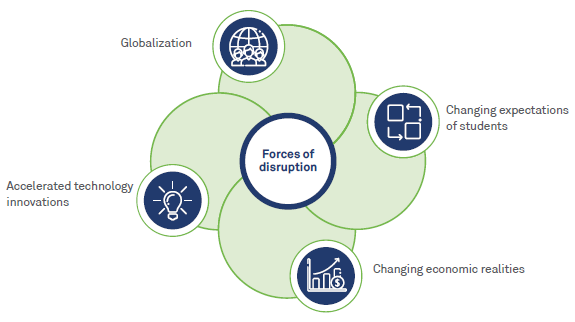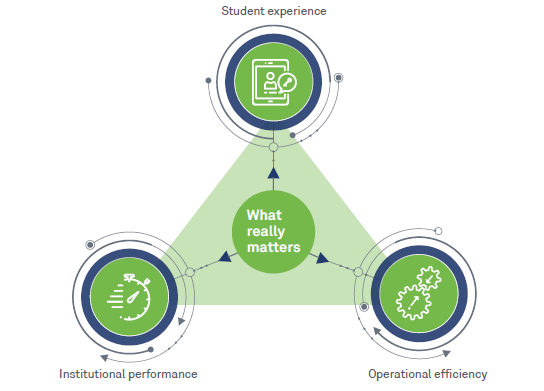Enterprises around the world have found that their customers are going digital at a pace never seen before. In the light of these developments, organizations are adopting innovative business models and latest digital technologies to enable them. ‘Digital transformation’ and ‘modernization’ are no longer just fancy words flying around. Embarking on this journey is now a necessity for organizations to adapt and survive.
The higher education industry is no exception. Although known to be slow to jump on to new technologies, universities are now looking towards providing more personalization to students to ensure high levels of student retention, engagement and peer competition; while making student interactions with the administration as frictionless as possible. The shift isn’t merely about automating discrete transactions, but to take a more comprehensive platform approach to remove departmental silos, enabling them to nurture and manage relationships with students across the entire lifecycle.
Challenges for modernization
While there is no debate around the need to transform and renew the institution, the difficulty of the path to be treaded varies from one university to the other. Some of the significant challenges that crop up are:
Forces of disruption for universities
While there may be challenges along the way, there are several crucial factors in play in the ecosystem of higher education that are disrupting the way this industry functions. As said before, there is no debate around the need to transform and renew the institution. Therefore, it is necessary to study these forces to understand how technology can be utilized to empower universities.

Figure 1: Forces of disruption for universities
Globalization
As universities attract students from across the globe, there is a need to:
Changing expectations of students
Universities are under constant pressure to identify and retain students of the highest quality. But in today’s world, as students expect a desirable ROI, there is an additional onus on the institution to empower its students financially.
Changing economic realities
Universities are heavily dependent on the funding they receive from various entities. However, all aspects of the business are moving towards an outcome-based focus. Consequently, the funding too has turned into a performance-based activity, which demands universities to up their game.
Accelerated technology innovations
Technological advancements allow universities to enhance the levels of student engagement and empower them with innovative education delivery models, perhaps even heading towards a ‘no physical classroom’ concept. This could potentially put an end to the traditional methods of knowledge dissemination to students, making universities extremely asset-light.
University needs & expectations – What matters?
There are several key expectations that universities want to meet with their modernization strategies, which can be primarily classified into:
Student experience: Enable personalized experience, empowering students concerning financial stability, employability and success
Institutional performance: Enhance program quality and reputation and foster life-long learning, thereby creating differentiation in the market
Operational efficiency: Optimizing enrollment management and several other vital processes, leveraging insights about the market and students to enhance institutional development and fund-raising; ultimately resulting in excellence

Figure 2: Needs and expectations of universities
The way forward
Life could change dramatically for universities if they adopted modern day technologies to meet the changing expectations of their ecosystem. For instance, a top university in North America chose an offering of integrated Cloud solutions and services to migrate its CX, ERP and HCM systems to the Cloud. This empowered the institution with vital information and insights to deliver better student experience, simplified various processes and workflows, and enabled better decision-making.
Such a journey to modernization firstly requires the institution to ascertain its desired business outcomes. Based on these goals, the institution will need to assess the strengths and capabilities of all the technologies, products and services available in the market to arrive at the ones most suitable for its scenario. The next step in the thought process is to establish the most optimal roadmap to undergo the transformation and ascertain success criteria to keep track of progress regarding the set goals being achieved.
Conclusion:
Today’s technological innovations hold the power to shake up the very foundations of the higher education industry. While the journey to change may not be easy, the positive outcomes are hard to ignore. Hence, it is critical for universities to embrace this change to gear up for an exciting future.
Gopal Reddy P, Head – Oracle HCM Applications Solutions and Delivery, Wipro Limited
Gopal leads Oracle HCM Applications Solutions & Delivery within Wipro. He is responsible for growth in business, solutions and delivery for Oracle HCM applications within Oracle Practice. Gopal has an overall 18+ years of experience in IT Service Delivery Management, PeopleSoft & HCM Cloud Practice Management, Solutions, Account Management, Pre-sales, and Business Strategy. He is an HR domain expert and demonstrated HCM thought leadership in Oracle Open World and various Oracle user group forums.
Gopal holds a certification of global leadership from Harvard publishing, managerial excellence from Duke University and a bachelor’s degree in Industrial & Production Engineering from Gulbarga University.